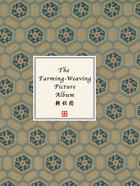
PREFACE
China has a time-honored agricultural history. Farming and weaving, as major components of production in ancient China, became popular themes of artistic creation in traditional Chinese agricultural society. The Illustrations of Agriculture and Sericulture (Geng Zhi Tu) is an exquisite artwork for studying traditional Chinese agricultural and sericultural technologies.
The Illustrations of Agriculture and Sericulture can be interpreted in both broad and narrow senses. In a broad sense, it can refer to all scattered images related to agriculture and sericulture in China, which date back as early as the Warring States Period (475-221 BC). In a more narrow sense, however, it refers specifically to a systematic series of images introducing agriculture and sericulture that originated from Lou Shu in the early Southern Song Dynasty(1127-1279). Lou’s work is divided into two sections: one on agriculture, and the other on sericulture. Section One includes 21 pictures illustrating the whole process of grain production, from soaking seeds to warehousing, while Section Two includes 24 pictures showing the procedures of silk production, from bathing for silkworms to trimming the fabric. Each systematic illustration of production is accompanied by a caption in the form of a poem, with five characters to a line.
Lou’s work received praise from emperors of later dynasties, and later editions were published from the Song Dynasty (960-1279) to the Qing Dynasty (1616-1911).
This edition is based on the Imperially Commissioned Illustrations of Agriculture and Sericulture (Yu Zhi Geng Zhi Tu) published by the Imperial Household Department in 1696, the 35th year of Qing Emperor Kangxi’s reign – painted by the imperial painter Jiao Bingzhen and carved by the imperial carvers Zhu Gui and Mei Yufeng. The most important and representative edition of the Qing Dynasty, it contains a total of 46 pictures, split evenly between agriculture and sericulture.
The Imperially Commissioned Illustrations of Agriculture and Sericulture differs from the Lou Shu edition in that it is prefaced by Emperor Kangxi, who expresses his thoughts on the toil of farming and weaving. Pictures titled Growing Seedlings and Honoring Gods were added to Section One, while Birth of Silkworms, Feeding Silkworms,and First Dormancy were removed from Section Two and replaced with pictures titled Dyeing Threads and Tailoring. On top of each picture is a poem written by Emperor Kangxi featuring seven characters to a line, with Lou Shu’s poems scripted on the blank. The sequence of images in this edition was also adjusted.
Though following the general layout of Lou’s edition, the Imperially Commissioned Illustrations of Agriculture and Sericulture depicts rural life in a different manner – presenting an idyllic picture of agricultural and sericultural production beaming with warmth, harmony, and peace of the rural life. The figures in different postures were elaborately and vividly painted on an accurate scale with delicate details, and when depicting architecture and looms, the painter combined traditional Chinese measured painting with the focus perspective of Western painting, adding to realism of the pictures.
This edition is based on the original one published by the Imperial Household Department of the Qing court. The preface bore a red seal inscribed “The Study of Literary Brilliance” at its beginning and two inscribed “Emperor Kangxi’s Autograph” and “Examining Ancient Experience and Emphasizing Cultural Education” at its end. Each poem also bore a red seal inscribed “The Study of Erudite Introspection” at its beginning and two inscribed “Emperor Kangxi’s Autograph” and “Maintaining the Ideal of Ultimate Harmony” at the end.
The Illustrations of Agriculture and Sericulture was not just a collection of images. It was a tool for promoting agriculture and sericulture, enhancing education, and securing social stability in ancient China. As time has passed, its role has evolved. It now serves as a first-hand material for the study of agricultural and sericultural technologies in ancient China. Featuring meticulous depictions of the scenes of farming and weaving, it is indeed one of the crown jewels of traditional Chinese culture.
Weng Lianxi
Researcher at the Palace Museum